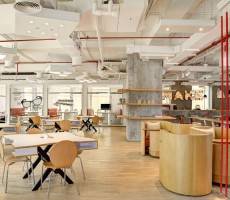June 29, 2015
Beyond agile working: the six factors of knowledge worker productivity
 Whilst the world has focussed heavily on the asset productivity of offices over the last 30 years, reducing the cost of offices per head, often using agile working as a tool for achieving this, it’s becoming clear that the mobility afforded by the latest technology products can be used to aid Knowledge Worker productivity. Knowledge work plays an increasingly large part in the economic fortunes of developing countries. Indeed the vast majority of people working in AWA’s client organisations are Knowledge Workers. Over the last 30 years we’ve seen a gradual shift from manufacturing to service and now to knowledge based industries. Knowledge Workers are broadly speaking ‘people who think for a living’. Whilst the concept of ‘productivity’ in manufacturing and service industries is well understood it is barely understood at all for knowledge based sectors.
Whilst the world has focussed heavily on the asset productivity of offices over the last 30 years, reducing the cost of offices per head, often using agile working as a tool for achieving this, it’s becoming clear that the mobility afforded by the latest technology products can be used to aid Knowledge Worker productivity. Knowledge work plays an increasingly large part in the economic fortunes of developing countries. Indeed the vast majority of people working in AWA’s client organisations are Knowledge Workers. Over the last 30 years we’ve seen a gradual shift from manufacturing to service and now to knowledge based industries. Knowledge Workers are broadly speaking ‘people who think for a living’. Whilst the concept of ‘productivity’ in manufacturing and service industries is well understood it is barely understood at all for knowledge based sectors.



















 Plans for what is billed as the tallest office building outside of London have been submitted to Birmingham City Council for approval. The proposed 26 storey tower at 103 Colmore Row is planned to stand 346ft (105m) and house some 2,000 office workers. Birmingham is bound to find the scheme attractive as it vies with Manchester for the crown of England’s second city. Up to now, tall buildings have not enjoyed the same appeal in regional cities as much as they have in London. The new building is planned to replace the former NatWest tower which has lain empty on the development site since 2003 and is set to be demolished once plans are finalised for its replacement. If given a green light, the new scheme will incorporate a rooftop restaurant, green roof, terraces, street level shops and cafes and a winter garden.
Plans for what is billed as the tallest office building outside of London have been submitted to Birmingham City Council for approval. The proposed 26 storey tower at 103 Colmore Row is planned to stand 346ft (105m) and house some 2,000 office workers. Birmingham is bound to find the scheme attractive as it vies with Manchester for the crown of England’s second city. Up to now, tall buildings have not enjoyed the same appeal in regional cities as much as they have in London. The new building is planned to replace the former NatWest tower which has lain empty on the development site since 2003 and is set to be demolished once plans are finalised for its replacement. If given a green light, the new scheme will incorporate a rooftop restaurant, green roof, terraces, street level shops and cafes and a winter garden.













July 1, 2015
Three ways in which the business case for green building design is moving on
by Dan Callegari • Architecture, Comment, Environment, Facilities management, Workplace design
(more…)